A beginner’s guide to raising calves for beef
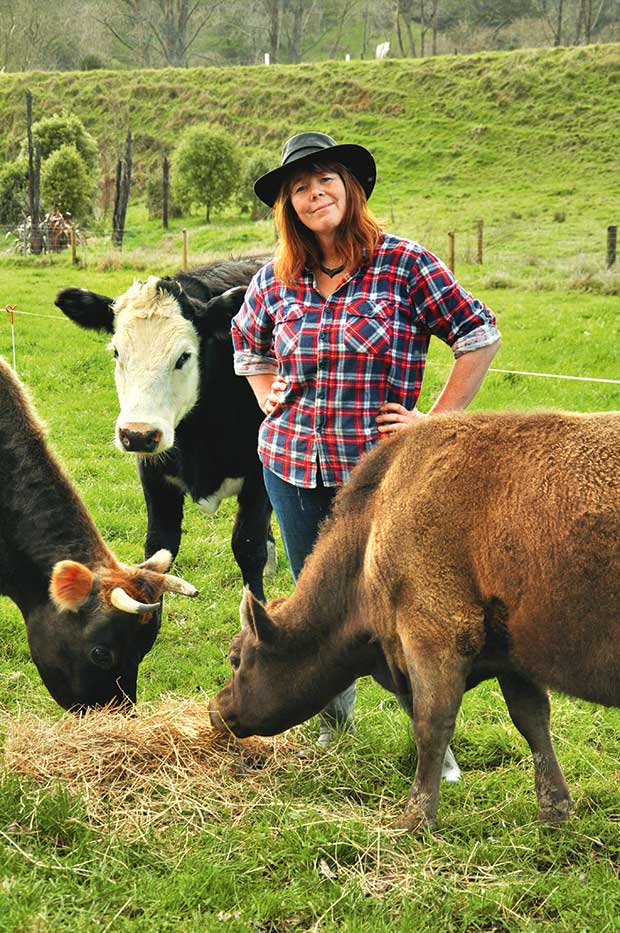
If you have the grass, buying calves and grazing them on is the best way to fill the freezer with lots of lovely beef.
Words: Sheryn Dean
Raising a couple of beefies is a relatively easy way to keep your grass under control and provide the family with meat.
An 18-month-old beast can provide over 150kg of beef. This is a lot of meat and will fill up a small chest freezer with top grade steak (whole eye fillet!), good sausages and everything in between.
5 BASIC REQUIREMENTS
1. You should never have just one animal by itself – isolation is a form a torture. Everyone needs a friend (who else is going to lick that scratch on their back?) so plan to have at least two beasts at any one time.
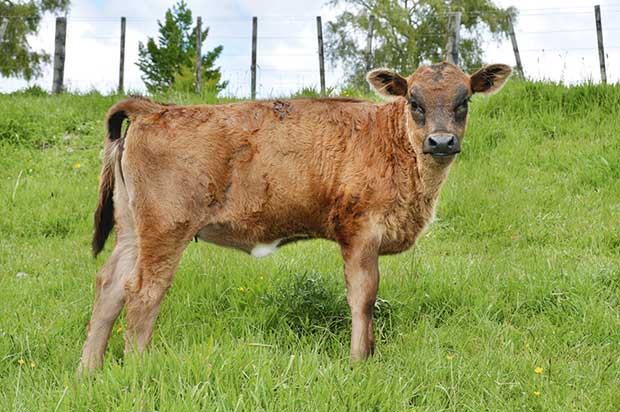
2. You need a minimum of 1ha (2.5 acres) of grazing land for two mature cattle. By that, I’m referring to prime grass-growing land in a benign climate. If that’s not your block, ask a neighbour what their stocking rate is to see what your land could possibly feed through a dry summer and a cold winter. My 2.8ha (7 acres) of good Waikato grass can carry seven cattle of various ages. I raise two calves a year and have 5-6 beef cattle/calves grazing at a time.
3. Graze the minimum number of beasts to start off with – it is much better to be understocked than overstocked. To work out exactly how much grazing area you have, use the Google Maps area calculator tool to outline your paddocks.
4. Ensure your boundary fences are stock proof.
5. You need at least two separate paddocks, preferably more, so you can rotate your grazing. The more paddocks you have and the more you can break-feed the better. Intensive farmers move their cattle daily (or more) but a weekly move onto new grass while the other paddocks regrow is sufficient. If you don’t have internal fencing, an electric fence system is an option and of course, every break/paddock needs water.
6. Know the legalities of owning cattle.
Anyone who owns cattle, even if it’s just one animal, must be registered with:
NAIT – the National Animal Identification and Tracing scheme
TBFree – the stock control system which aims to eradicate tuberculosis (TB) in NZ
Both are free services. OSPIRI manages these two national programmes: (0800 482 463), ospri.co.nz. The NAIT registration can be done online, but the TBfree requires a form to be completed which its help desk can provide details for. Register before you purchase your calves. A seller will require your NAIT number, and you will need to update your NAIT status when you get your cattle home. It’s also a good idea to take note of the seller’s NAIT number. The seller will also provide you with an ASD form (Animal Status Declaration) which shows their herd’s TB history.
OPTION 1: WEANERS
Age: 8-12 weeks, over 100kg, the older the better
Price: approximately $500 per calf
The easiest way to start is to buy two weaners. These are calves old enough to eat grass. Ensure the ones you buy are already eating grass, not just grain. If they are receiving grain supplements, continue feeding it as you gradually change their diet to grass.
Don’t force a sudden complete diet change on any livestock as their stomachs can’t digest the new food.
OPTION 2: CALVES
Age: four days old+, preferably 7-10 days
Price: approximately $100 or less, depending on the season
Buying four-day-old calves and raising them yourself takes more work but is fun for the children to be involved. You will need a shed to shelter them in for the first few weeks.
You can source a calf for less than $100 in season (July to November) but prices can be higher depending on demand. Be wary of paying more as it may be more economical to buy a weaner by the time you calculate how much milk powder it will cost to get the calf to the weaning stage. This is at the very least one, but preferably two bags of milk powder which are around $100 each.
If you can get a farmer to raise the calf until it is 7-10 days old, the calf will do a lot better and you will get an animal that is past the riskiest time period.
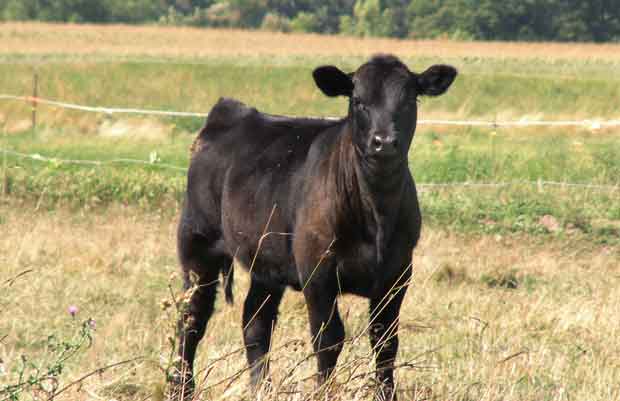
WHY IT’S BEST TO GO FOR A BEEF BREED
Beef breeds will provide a lot more meat on killing than a milking breed, so it is false economy to buy the cheaper bobby calves.
Most calves available are from the dairy industry and are a cross breed, a milking cow mated with a beef bull. I prefer Murray Grey-cross calves as they have quiet temperaments (although too quiet and they can easily become a pet!), but all the beef breeds have done well for me.
9 TIPS FOR CHOOSING A GOOD CALF
Calves should be:
• at least four days old (older is better)
• weigh over 40kg
• strong, energetic and happy
Never buy a calf that is not 100 per cent well. A sick calf can die very quickly, bring disease onto your property that you can never eliminate and infect other cattle.
You also need to check:
• eyes – should be bright and alert, not sunken
• ears – alert, not drooping
• rear end – clean, with no sign of diarrhoea
• knees – not swollen or sore
• navel – not infected or swollen
Check with the farmer that they were fed sufficient colostrum in the first few hours after birth as this sets their digestion system up for life.
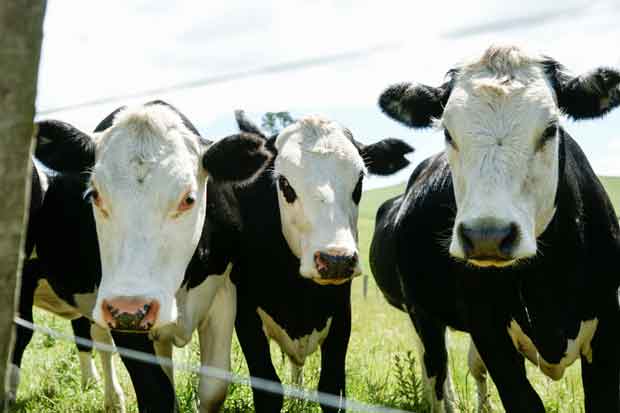
THE COMMON BREEDS ON NZ FARMS
Milking breeds
• Jersey
• Friesian
• ‘Kiwi-cross’ (Jersey x Friesian)
• Holstein or Holstein Friesian
• Ayrshire
Common beef breeds crossed with dairy cows
• Hereford
• Angus
• Murray Grey
SOURCING YOUR STOCK
TradeMe can be a good place to find a couple of weaners for sale. Negotiate on purchase with the seller to drench for parasitic worms as you collect. Get them to do this in front of you as you load them, even if they say it has recently been done.
The best way to source four-day-old calves is from a dairy-farming friend/neighbour. If you don’t have one, make one. Introduce yourself to a nearby farmer, ask in advance if you can buy some calves from them when they are ready, ask if they will raise them the few extra days for you and show your appreciation with something extra like a box of chocolates or beer, or a bottle of wine.
You will get much healthier and better calves.
Ask the farmer what they are feeding them. Buy the same brand of milk powder or if it is milk from the vat, ask for a bucket of milk so you can gradually change over to your milk. Once again, sudden changes to diet can be detrimental and the younger the calf, the more delicate their digestive system.
Alternatively you can ask a livestock agent to source calves for you. Contact an agent through your rural supply store. However, in 20 years of dealing with various agents I have yet to make a good relationship with one as they don’t seem interested in dealing with just a couple of animals at a time.
You can buy at the auction at your local sale yards, but this gives you the disadvantage of not being able to deal directly with the farmer.
GETTING THEM HOME
Ideally you will have a trailer with a stock crate, a cover and lined with a non-slip rubber mat. In reality that is a big investment if you’re only getting a couple
of calves once a year.
A trailer with four suitably-sized gates* securely tied together, a trailer net over the top (trust me, these little fellas can jump), a piece of corrugated iron across the front to break the wind, and an old piece of carpet on the floor is perfectly adequate. Without the carpet, the nervous poos and wees make the trailer slippery and dangerous.

A horse float can be utilised but if transporting weaners, put a trailer net over any gap above the back door. They can and will jump out while you are driving at 100km an hour.
Another option is to negotiate with the seller to see if they will deliver.
To get the calves into the shed, I give them a finger in the mouth to suck and half-push, half-pull them, as they’re too heavy for me to carry.
SETTLING IN
Weaners need to be drenched when you collect them. Buying drench for a few animals is expensive so try to negotiate that the farmer does this for as you load them. Otherwise, ask your vet for individual doses.
Young weaners are very susceptible to worms as they have not yet developed their own resistance and you don’t want them dropping worm eggs onto your paddocks.
Hold them in a quarantine yard for 24 hours while they expel their worm burden and ideally do not graze that quarantine area for at least three months.
Ensure this first pen/paddock is secure. Stock yards are perfect. Animals can make Houdini-like escapes in the first day or two if they can. Ensure they have water and hay, grass or grain (if that has been their previous diet) and let them get used to you.
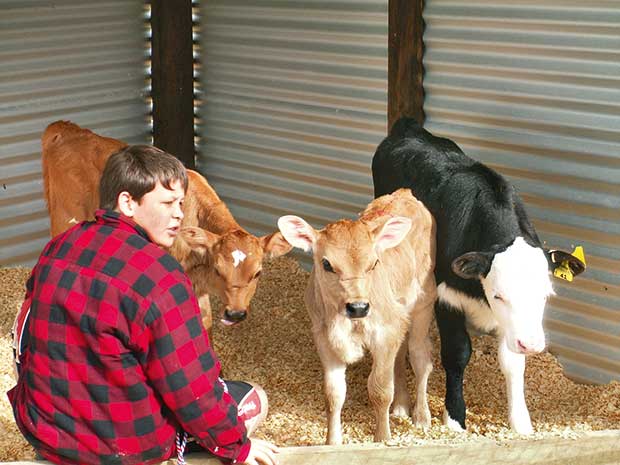
Shadow, Shaphire and Dinner.
If you don’t have yards, make sure your fences are 100 per cent stock-proof, especially around drains and waterways, and keep a close eye on them.
Four-day-old calves are a bit trickier to settle in. If something is going to go wrong, it will in those first few days. They need a dry, warm, draught-free but ventilated shed with a straw or wood shaving bed base and access to water at all times, plus milk and supplemental grain.
The easiest way to raise four-day-old calves is to mother them onto a nurse cow, a lactating cow of maternal temperament who will act as a surrogate mother. This is a subject I’ll write about in a separate column.
MAKE UP A DIY PEN
It is worth investing in four gates or panels you can tie together to make a pen that fits on your trailer to make a stock crate. These can be stored easily and are versatile, they can be used for anything from containing a new-born lamb to keeping animals out of a new vegetable patch.
Love this story? Subscribe now!
 This article first appeared in NZ Lifestyle Block Magazine.
This article first appeared in NZ Lifestyle Block Magazine.
